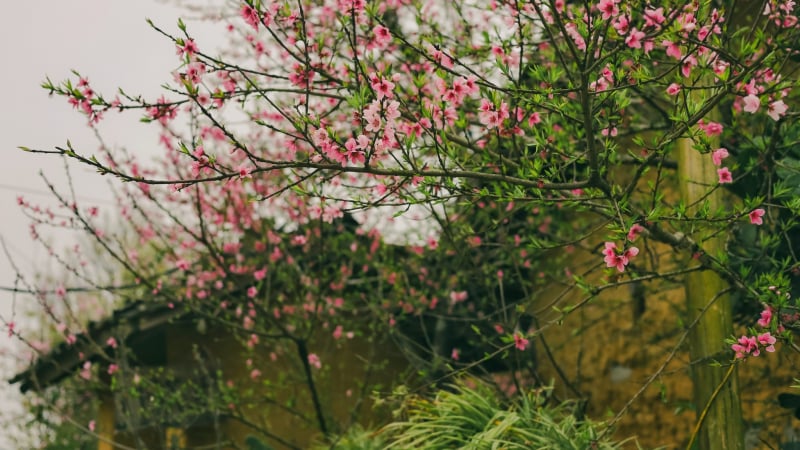When the chilly winds of late autumn and early winter begin to creep through the hillsides, the rocky plateau of Northeastern Vietnam puts on a new, romantic and strangely charming coat: the color of buckwheat flowers. This typical flower of the mountains and forests has long gone beyond its traditional food value, becoming a highlight attracting tourists and photographers from all over. The image of the fields of tiny flowers stretching out, precariously on the cat-ear rocks, has turned the land at the head of the Fatherland into a poetic, majestic but also extremely familiar natural picture.
The best time to admire this surreal beauty is from the end of October until the end of December. This is the time when buckwheat flowers bloom, creating a unique scene spread across the hillsides, terraced fields, along the roads and at the foot of the mountains. The appeal of this flower lies in the change of color over time and temperature.

When visiting buckwheat flower season, visitors can also see images of Mong ethnic children, barefoot, holding hands with innocent faces, playing in the flower fields.
When first blooming, buckwheat flowers have a pure white or gentle pink color. Then, when the temperature drops and the cold air covers, the flowers gradually turn dark pink or purple before fading. The purple-pink color at this time is considered the most beautiful time of the flower, when the petals gather into a cone shape, creating a majestic and poetic sea of flowers amidst the majestic mountain and forest scenery.

Flowers cover the hillsides, terraced fields, along the roads and at the foot of the mountains, creating a unique landscape of the rocky plateau.
The blooming period lasts about a month, depending on the weather conditions each year. Visitors who love the flower season should proactively plan early to have the most complete experience, enjoying the beauty of this "memorable" flower.
Although appearing in many provinces in the Northeast, Tuyen Quang is still the most prominent destination. Especially in Tuyen Quang, the pink color of buckwheat flowers stretches into fields, precariously on cat-ear rocks and hidden behind ancient villages of ethnic minorities. All blends with the mountains, terraced fields interspersed with corn fields and winding streams, creating a multi-dimensional, poetic natural picture.

Buckwheat flowers are white when they first bloom, then gradually turn pink and purple before fading.
Visiting the flower season, tourists can also witness unique cultural images. Lo Lo or Mong ethnic girls dressed in brocade dresses in the middle of the flower forest create a typical image of the mountainous land. Tourists can rent ethnic costumes to take pictures, preserving the unique mark of the rocky plateau. However, tourists should note that the weather when buckwheat flowers bloom in Tuyen Quang is quite cold, so preparing thermal clothing and warm clothes is extremely necessary.

This is also the time that attracts many tourists to admire and take artistic photos.
In addition, the image of a Mong ethnic child, barefoot, holding hands with an innocent face, playing in a flower field, with a mischievous, crisp laugh, are everyday, rustic but very familiar moments, making visitors feel like they are returning to their childhood many years ago.
Previously, buckwheat flowers were mainly grown for their seeds, which were used to make cakes to prevent hunger during the lean season. Buckwheat seeds were also used as a traditional medicine, with an astringent, slightly spicy taste, neutral properties, and the effects of relieving rheumatism, eliminating swelling, clearing heat and detoxifying. In addition, local people still use buckwheat as an ingredient to prepare many traditional dishes such as buckwheat cakes, wine and some other highland specialties.

However, thanks to the strong development of the tourism industry, this flower, which was thought to have only food value, has become more known to tourists. Nowadays, to serve the needs of tourists for sightseeing and photography, Tuyen Quang people have planted flowers in alternating seasons, extending the blooming period from early autumn to the end of winter. Thanks to that, tourists can see the flowers at more times of the year, not just during festivals.

Here, in addition to admiring flowers, visitors can also explore the majestic natural landscape with overlapping mountains, terraced fields interspersed with corn fields, and winding streams at the foot of the mountain.
To honor the cultural and tourism value of this flower, the locality often organizes the Buckwheat Flower Festival with many unique activities. Coming to the festival, visitors can not only admire the flower fields but also experience a series of unique cultural and sports activities, contributing to creating a colorful journey.
The buckwheat flower festival is not only a symbol of tourism but also the main source of income for people in the border area, contributing significantly to the socio-economic development of Tuyen Quang province in a sustainable direction, transforming from a difficult land into a prominent cultural and natural destination of the Northeast region.

 EN
EN



































